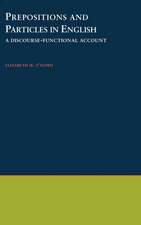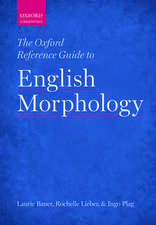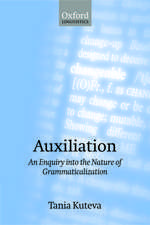The Oxford Encyclopedia of Morphology: 3-volume set
Editat de Rochelle Lieberen Limba Engleză Hardback – 23 mar 2021
Preț: 2684.25 lei
Preț vechi: 4019.95 lei
-33% Nou
Puncte Express: 4026
Preț estimativ în valută:
513.62€ • 537.71$ • 424.99£
513.62€ • 537.71$ • 424.99£
Carte disponibilă
Livrare economică 04-10 martie
Preluare comenzi: 021 569.72.76
Specificații
ISBN-13: 9780190682361
ISBN-10: 0190682361
Pagini: 2300
Ilustrații: 31 illustrations
Dimensiuni: 315 x 241 x 158 mm
Greutate: 5.18 kg
Editura: Oxford University Press
Colecția OUP USA
Locul publicării:New York, United States
ISBN-10: 0190682361
Pagini: 2300
Ilustrații: 31 illustrations
Dimensiuni: 315 x 241 x 158 mm
Greutate: 5.18 kg
Editura: Oxford University Press
Colecția OUP USA
Locul publicării:New York, United States
Recenzii
One of the assets of the third volume is the very same degree of cohesion and clarity which is maintained throughout the three-volume set. Additionally, there is rich, cross-linguistic (where necessary) exemplification of the morphological phenomena/structures under examination. Diverse topics, morphological phenomena, and approaches/frameworks are thoroughly presented and supported by reference to well-established research studies ... Overall, The Oxford Encyclopedia of Morphology makes a strong contribution to the field and it will satisfy academics and researchers at different levels of expertise and/or experience. It is an extremely valuable source of reference for the community of linguists.
Contributors offer empirical, cross-linguistic evidence which exemplifies and supports the theoretical discussion, thus enabling the reader to get a better grasp of the topic. The richness of the references is also impressive. The contributors successfully manage to guide readers through years of research within a couple of well-written pages. Finally, the coherence and clarity which characterised the articles in the first volume are maintained in this one.
The volume is well-written and the discussions are easy to follow...The Oxford Encyclopedia of Morphology will satisfy the needs of experts or newcomers to the field, who will certainly find something interesting to challenge themselves with.
Contributors offer empirical, cross-linguistic evidence which exemplifies and supports the theoretical discussion, thus enabling the reader to get a better grasp of the topic. The richness of the references is also impressive. The contributors successfully manage to guide readers through years of research within a couple of well-written pages. Finally, the coherence and clarity which characterised the articles in the first volume are maintained in this one.
The volume is well-written and the discussions are easy to follow...The Oxford Encyclopedia of Morphology will satisfy the needs of experts or newcomers to the field, who will certainly find something interesting to challenge themselves with.
Notă biografică
Rochelle Lieber is a theoretical linguist specializing in morphology, the mental lexicon, and the structure of English. She has taught in the University of New Hampshire's English Department since 1981. She has been the recipient of a UNH Teaching Excellence Award (1990), the Lindberg Award for the outstanding scholar/teacher in the College of Liberal Arts (2013), and the Linguistic Society of America's Bloomfield Award for best book in Linguistics (2014) for the Oxford Reference Guide to English Morphology (co-authored with L. Bauer and I. Plag). Her books include English Nouns: The Ecology of Nominalization (2015) and Introducing Morphology (2015).



























